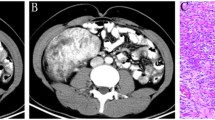Abstract
Purpose
The purpose of this study was to investigate the imaging characteristics of solitary fibrous tumor (SFT) in the abdomen and pelvis.
Methods
Nine cases of SFT confirmed by surgery and pathology were retrospectively analyzed in terms of computed tomography (CT, eight cases) and magnetic resonance imaging (MRI, one case).
Results
SFT were located in the retroperitoneum (4/9), abdominal cavity (1/9), pelvis (4/9). Eight cases were single (8/9) and one case (1/9) with three tumors. The average tumor size of 11 lesions was 9.7 cm (4.7–20 cm). Nine tumors were round or ovoid, and two lesions were irregular. The CT value of the plain scans ranged from 33 to 43 Hounsfield units (HU, mean 37.6 HU) in five cases. Arterial-phase CT found solid parts demonstrate avid enhancement (eight cases) and five of them presented with multiple circuitous vessels along the periphery with a CT value of 68–89 HU (mean 76.6 HU). In the venous and delayed phases, enhancement was strengthened progressively. The CT values at venous (eight cases) and delayed phases (five cases) were 108–115 and 112–123 HU respectively, with averages of 109.8 and 114.8 HU. Patch or nodular no-enhanced areas were observed in eight cases during the enhanced phases. One case showed isointensity on T1-weighted images and high signal intensity on T2-weighted images accompanied by linear or curvilinear hypointense lines. Intense enhancements along with linear no-enhancement areas are seen in the arterial and venous phases.
Conclusion
The possibility of SFT should be considered when a single or multiple masses with sharp border, inhomogeneous density or signal are detected, especially, with inhomogeneous intense enhancement in the arterial phase being maintained in the venous and delayed phases.



Similar content being viewed by others
References
Shanbhogue AK, Prasad SR, Takahashi N, et al. (2011) Somatic and visceral solitary fibrous tumors in the abdomen and pelvis: cross-sectional imaging spectrum. Radiographics 31:393–408
Briselli M, Mark EJ, Dickersin GR (1981) Solitary fibrous tumors of the pleura: eight new cases and review of 360 cases in the literature. Cancer 47:2678–2689
Goto Y, Sakurada T, Suzuki I, Nanjo H, Masuda H (1997) A localized fibrous tumor (mesothelioma) in the mediastinum: report of a case. Surg Today 27:871–873
Zukerberg LR, Rosenberg AE, Randolph G, Pilch BZ, Goodman ML (1991) Solitary fibrous tumor of the nasal cavity and paranasal sinuses. Am J Surg Pathol 15:126–130
Nakatani T, Tamada S, Iwai Y (2002) Solitary fibrous tumor in the retroperitoneum: a case with infiltrative growth. Acta Urol Jpn 48:637–641
Ginat DT, Aqiba B, Shweta B, Vikram D (2011) Imaging features of solitary fibrous tumors. AJR 196:488–495
Kubota Y, Kawai N, Tozawa K, et al. (2000) SFT of the peritoneum found in the prevesical space. Urol Int 65:53–56
Takizawa I, Saito T, Kitamura Y, et al. (2008) Primary solitary fibrous tumor (SFT) in the retroperitoneum. Urol Oncol 26:254–259
Weon YC, Kim EY, Kim HJ, et al. (2007) Intracranial solitary fibrous tumors: imaging findings in 6 consecutive patients. AJNR 28:1466–1469
Fine SW, McCarthy DM, Chan TY, Epstein JI, Argani P (2006) Malignant solitary fibrous tumor of the kidney: report of a case and comprehensive review of the literature. Arch Pathol Lab Med 130:857–861
Ide F, Obara K, Mishima K, Saito I, Kusama K (2005) Ultrastructural spectrum of solitary fibrous tumor: a unique perivascular tumor with alternative lines of differentiation. Virchows Arch 446:646–652
Fukunaga M, Naganuma H, Ushigome S, Endo Y, Ishikawa E (1996) Malignant solitary fibrous tumour of the peritoneum. Histopathology 28:463–466
Rosado-de-Christenson ML, Abbott GF, McAdams HP, Franks TJ, Galvin JR (2003) Localized fibrous tumors of the pleura. Radiographics 23:759–783
Moser T, Nogueira TS, Neuville A, et al. (2005) Delayed enhancement pattern in a localized fibrous tumor of the liver. AJR 184:1578–1580
Fuksbrumer MS, Klimstra D, Panicek DM (2000) Solitary fibrous tumor of the liver: imaging findings. AJR 175:1683–1687
Cardinale L, Allasia M, Ardissone F, et al. (2006) CT features of solitary fibrous tumour of the pleura: experience in 26 patients. Radiol Med 111:640–650
Author information
Authors and Affiliations
Corresponding author
Rights and permissions
About this article
Cite this article
Tian, TT., Wu, JT., Hu, XH. et al. Imaging findings of solitary fibrous tumor in the abdomen and pelvis. Abdom Imaging 39, 1323–1329 (2014). https://doi.org/10.1007/s00261-014-0155-4
Published:
Issue Date:
DOI: https://doi.org/10.1007/s00261-014-0155-4




